Love Data Week 2024
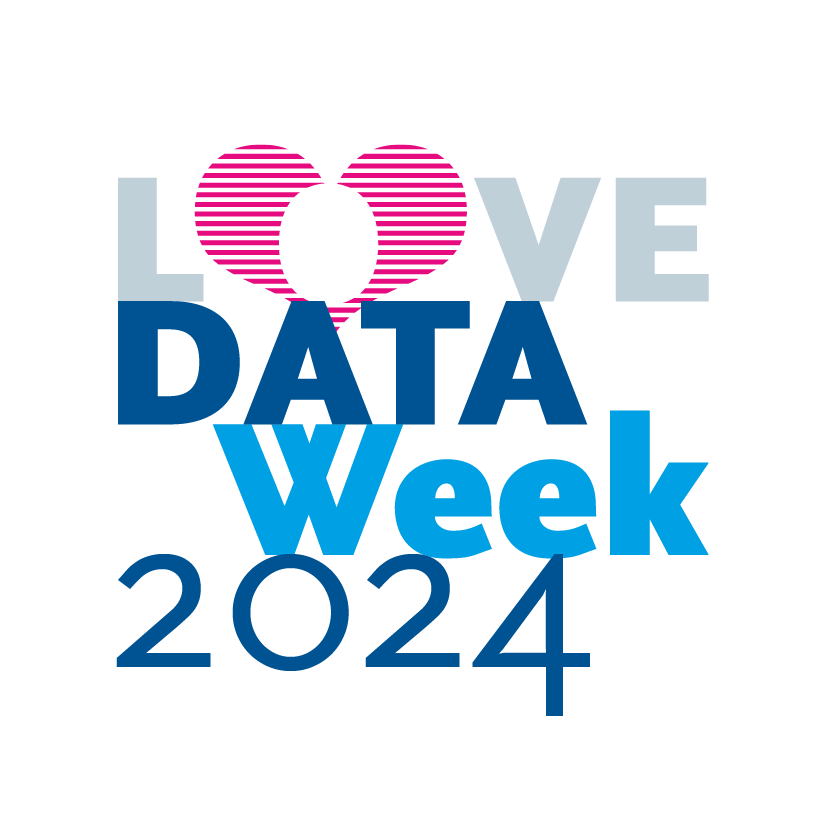
We love data - and as part of Love Data Week, we are presenting you a practical application example every day
Love Data Week (LDW) is an international week of action centred around research data and research data management. Under the motto ‘My Kind of Data’, data love 2024 will be celebrated worldwide from 12 - 16 February with numerous events on a wide variety of topics.
We at NFDI4Objects are taking the LDW as an opportunity to give you an insight into the work of our consortium with a wide variety of data sets. Every day, we will present a practical application example from one of our task areas. In this way, we want to make the abstract topic of research data management for the material heritage of human history a little more accessible every day.
12.02.2024: 3D modelling and 3D scans (TA1)
The life of FAIR research data on the material heritage of human history begins on the excavation site. With the help of three-dimensional documentation methods, objects and building structures can be digitally recorded. What methods are available? A brief overview.
SfM Photogrammetry
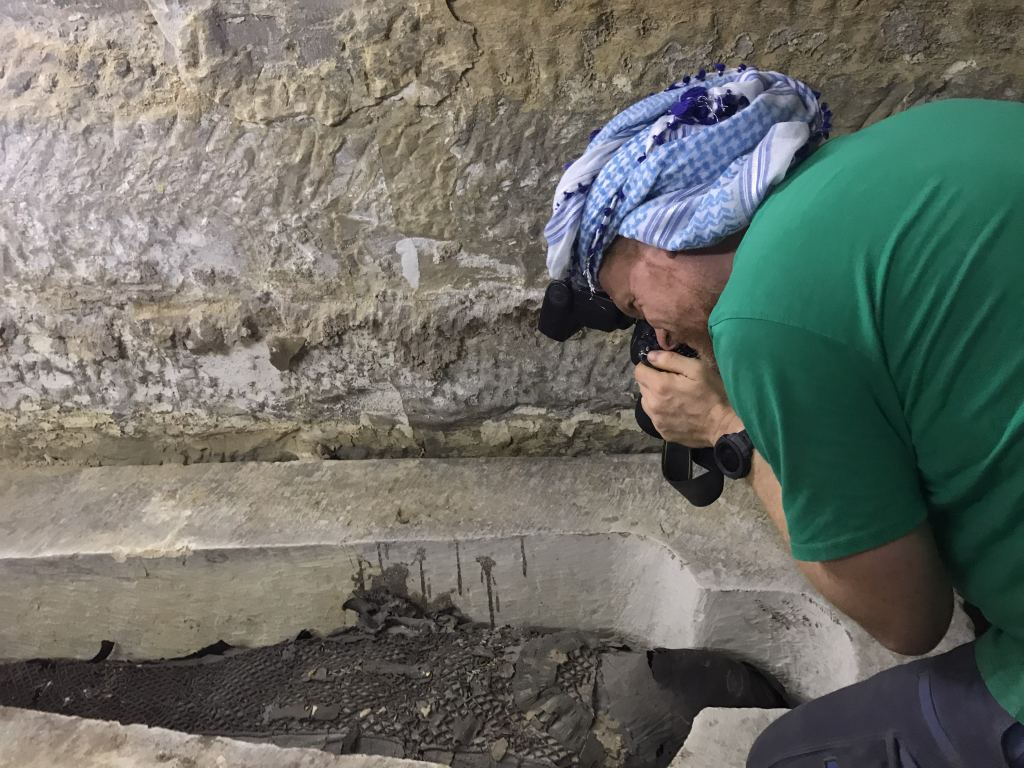
Image: Photo documentation of an object for image-based modelling / Matthias Lang, University of Bonn, BCDH
A large number of individual digital photos of all areas of the surface of an object or building structure are subsequently converted into a point cloud. Software is used to identify identical pixels and their spatial relationship to each other. The resulting point cloud can then be meshed to create a 3D model of the target object. The advantages of this method are the relatively simple availability and the inclusion of the optical colour information of the object’s surfaces.
3D-Laserscanning

Image: Airborne LiDAR scan of a landscape / Matthias Lang, University of Bonn, BCDH
Laser scanning methods are based on the combination of a distance measurement and a measurement of the reflection intensity using an emitted laser pulse. Airborne scanners can use this method to create large-scale surface models, e.g. of sections of terrain for prospection. Stationary scanners can also be used to capture building structures, while mobile, hand-held devices can also be used for smaller objects. The advantages of the method lie in the large-scale, rapid recording of surfaces.
Optical scanners (strip light scanning)
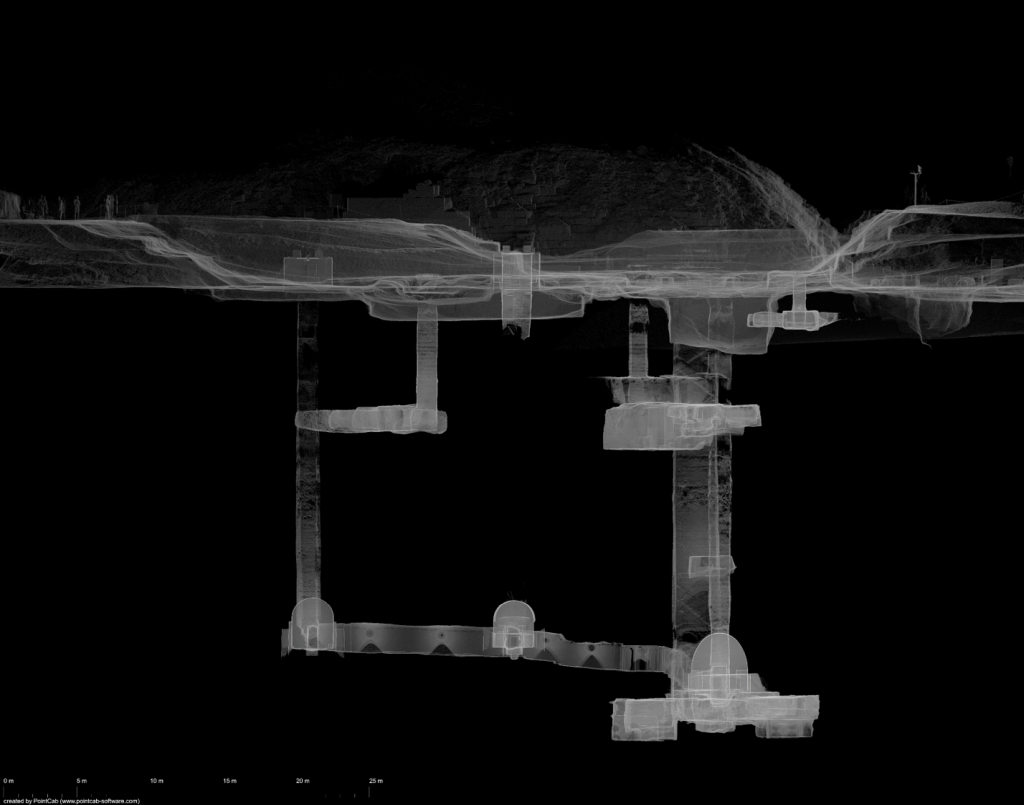
Image: Model of a terrestrial laser scanner / Matthias Lang, University of Bonn, BCDH
A point cloud is generated by utilising the optical distortion of a sequential light pattern on the object surface due to the spatial distance between the projector and sensor. The advantage is the accuracy of the surface representation. White light scanning methods can also be used for microscopic applications.
To ensure that these visualisations can be used in the long term, a standardised digital research data infrastructure is essential. However, the creation of such a portal brings its own challenges.
13.02.2024: Provenance research (TA2)
The topic of provenance is highly relevant, as debates surrounding the exhibits in the Humboldt Forum in Berlin, for example, show. In the field of provenance research, a FAIR research data infrastructure enables standardised and simpler research into the ownership history of objects. This is the subject of our Task Area 2: Collecting.
What is provenance research?
Provenance research deals with the origin of objects. Researchers endeavour to reconstruct in whose possession an object has been in the course of its existence. Ideally, all previous owners can be traced from the production of a work of art to the present day. Provenance research is not only concerned with art and cultural artefacts, however, but also with scientific objects.
Who uses provenance research?
Provenance research is used as a scientific instrument in public institutions such as museums, archives and libraries. It is also used by private collections and the art trade to determine the history of collection items.
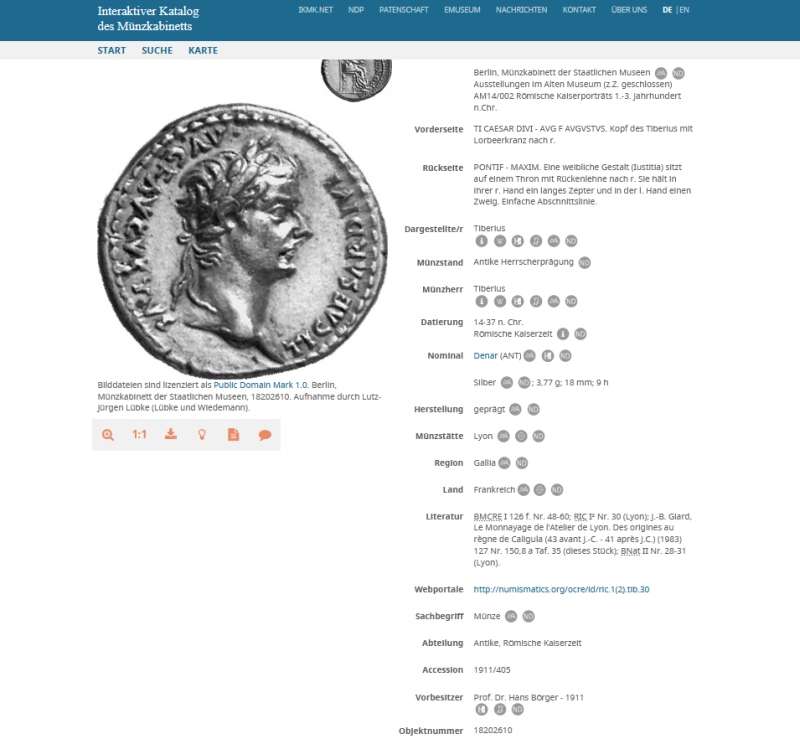
Image: Object entry in the digital catalogue of the Coin Cabinet / Münzkabinett Staatliche Museen zu Berlin
Why do we need provenance research?
We need provenance research to clarify the legality of an object’s ownership. It is a tool that offers the opportunity to gain additional information on the history of collection objects. Previous findings can be supplemented, confirmed or revised and unlawful ownership can be uncovered. If it is established that the art in question is looted or stolen, restitution processes can be initiated. This enables social and political reappraisal.
How does provenance research work?
Information about the former owners of objects can be found in many places. Often the first clue can be found on the objects themselves. Stamps, stickers or inscriptions such as an inventory number may be attached to the back or underside of larger objects. Sometimes smaller objects are also accompanied by slips of paper on which previous owners have noted information, e.g. at which auction the object was purchased. Other sources such as auction catalogues or acquisition and inventory books from collections can also provide valuable information for provenance research.
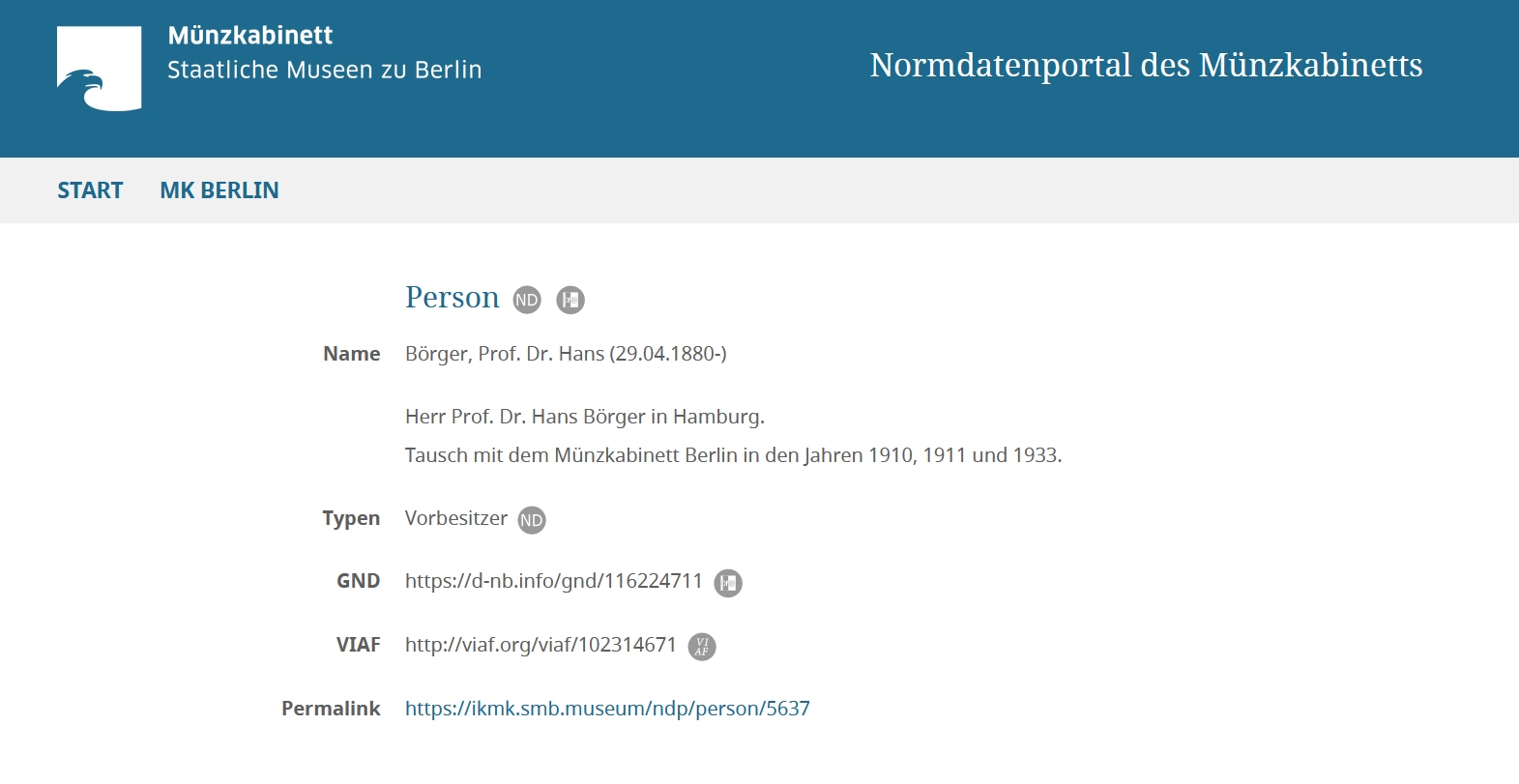
Image: Person entry in the standardised data portal of the Coin Cabinet / Münzkabinett Staatliche Museen zu Berlin
How is the data stored and managed?
Important data for provenance research are, on the one hand, the persons and institutions associated with the object and, on the other hand, the chronological events associated with the object. Ideally, these can be catalogued consistently so that a complete biography of the object is created. We will return to the exciting topic of object biography on Friday. By using standardised data in the field of digital provenance research, the data of previous owners can be linked in such a way that a former collection can be reconstructed across several databases.
14.02.2024: Monument protection (TA4)
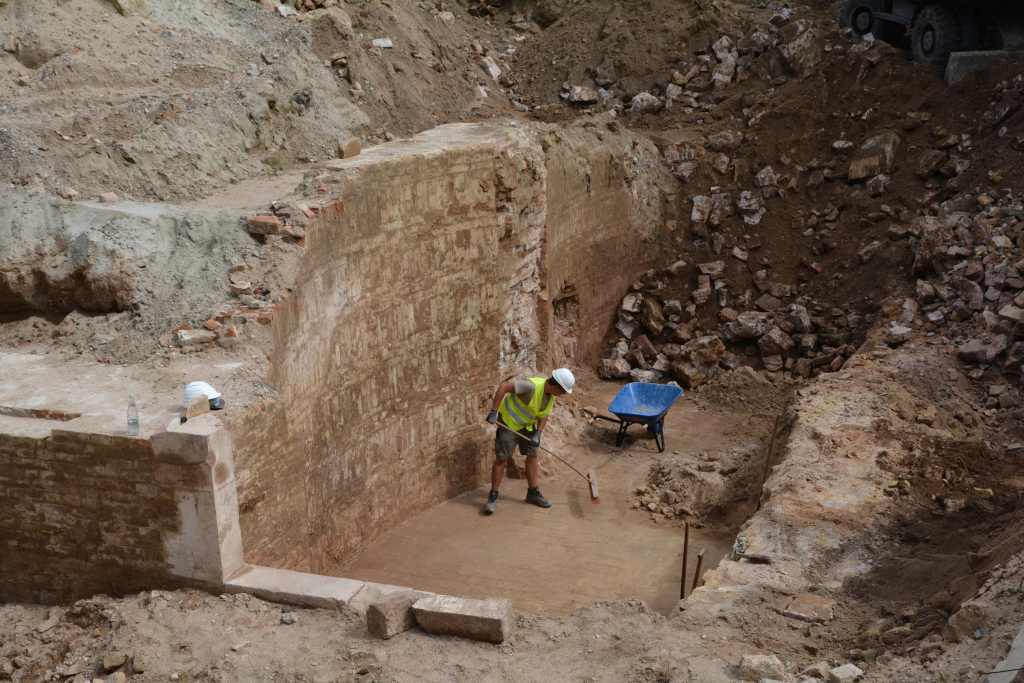
Image: Protecting archaeological monuments - that is the aim of Task Area 4 / Bernd Fischer, GDKE Landesarchäologie Speyer
On the third day of the LoveDataWeek campaign week, we are focusing on monument protection.
In Germany, cultural monuments are the responsibility of the federal states. The way in which they are recorded is correspondingly inconsistent. Different designations, chronologies and legal regulations make it difficult to exchange data across national borders. This poses problems for researchers, but also has a direct impact on the handling of these testimonies to our history as part of nationwide projects. For example, the Federal Network Agency recently decided to only take into account standardised information across Germany and therefore only UNESCO World Heritage Sites in its environmental assessment for the expansion of power lines. All other monuments thus remained unprotected.
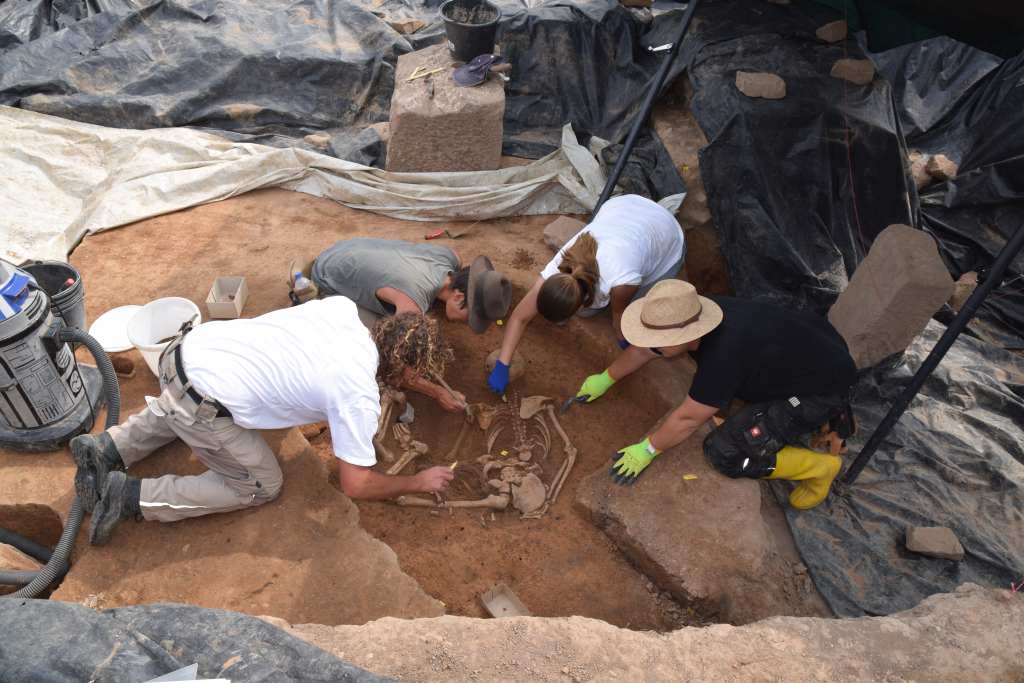
Image: Excavation workers uncovering a feature / Laura Bauer, GDKE Landesarchäologie Speyer
The solution? An interface for data exchange that connects the different systems with each other, makes them compatible and thus allows us to speak with one voice nationwide on issues of monument protection. This is one of the aims of Task Area 4: Protecting (TA4) of NFDI4Objects.
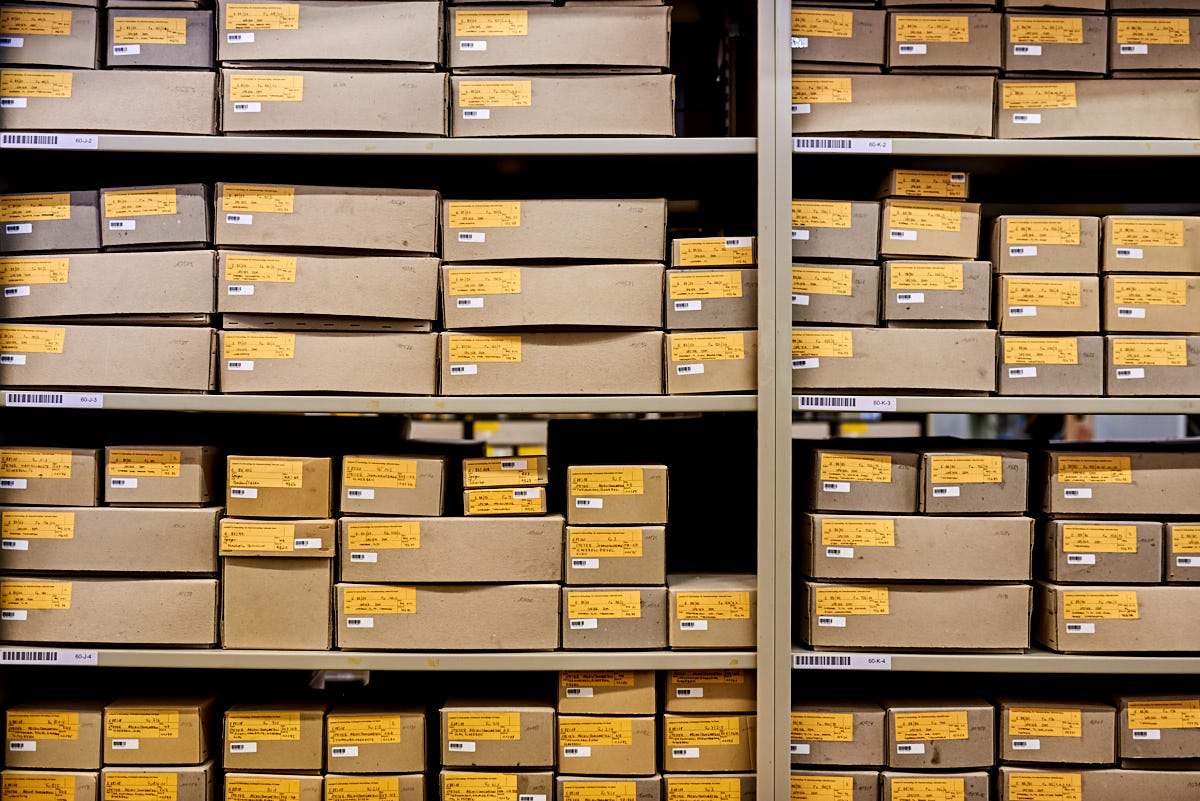
Image: Stacked boxes of artefacts / Tim Hufnagl, GDKE Landesarchäologie Speyer
15.02.2024: ArboDat and IANUS (TA3 & TA5)
The long-term archiving of research data in the field of the material heritage of human history is a central task of NFDI4Objects. Day 4 of LoveDataWeek will focus on two databases that are being developed by task areas of our consortium.
ArboDat+
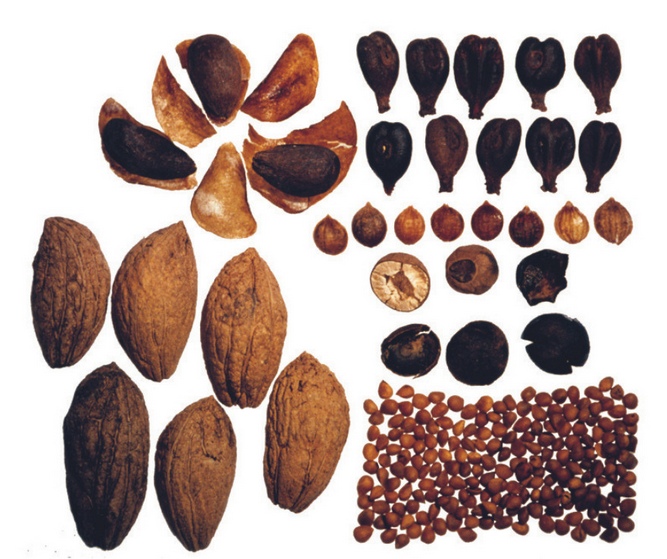
Image: Historical plant remains / Lower Saxony Institute for Historical Coastal Research
What is ArboDat+?
The ArboDat software was developed in 1997 as a database for archaeobotany at the Hesse State Office for the Preservation of Historical Monuments under the direction of Prof Angela Kreuz. The software is an important tool for recording and analysing archaeobotanical data and facilitated the creation of data tables for publications. In 2016, the copyright was transferred to the NIhK, which is now responsible for distribution and licensing. The current ArboDat 2018 software is available free of charge in German, English and French. ArboDat+ aims to make the existing software more accessible, user-friendly, multilingual and flexible, while retaining the core functionalities. The further development of this software will improve research into historical interactions between humans and the environment in the long term.
Who is responsible for ArboDat+?
ArboDat+ is an initiative funded by the German Research Foundation (DFG) as part of the National Research Data Infrastructure (NFDI). The aim is to advance archaeobotanical research through technological innovation. The project is a joint project of NFDI4Objects (Task Area 3: Analytics and Experiments), the Lower Saxony Institute for Historical Coastal Research (NIhK), the Institute of Pre- and Protohistoric Archaeology (UFG) and the Institute of Informatics (IfI) at Kiel University.
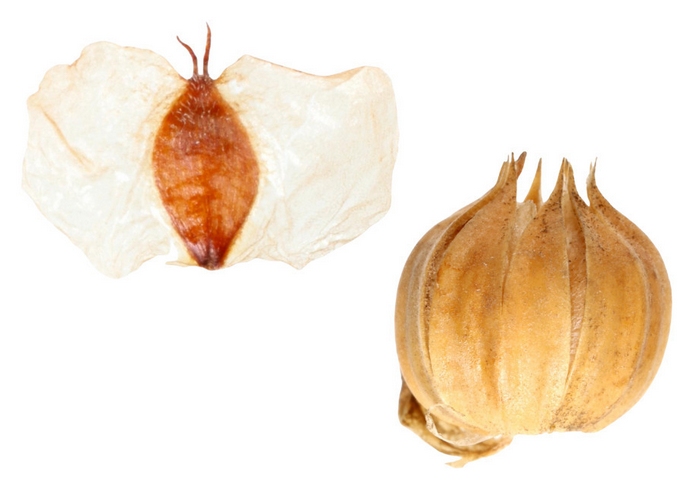
Image: Historical plant remains / Lower Saxony Institute for Historical Coastal Research
What’s next?
In the long term, ArboDat+ is to be redesigned as a database to make it more accessible and adaptable without deviating from the effective structure of the original. National and international connectivity is also to be ensured. Community participation is particularly important for ArboDat+: feedback can be submitted via the forum on our website www.arbodat.info. The website also serves the community as a place to exchange information, updates and ultimately the software itself.
IANUS
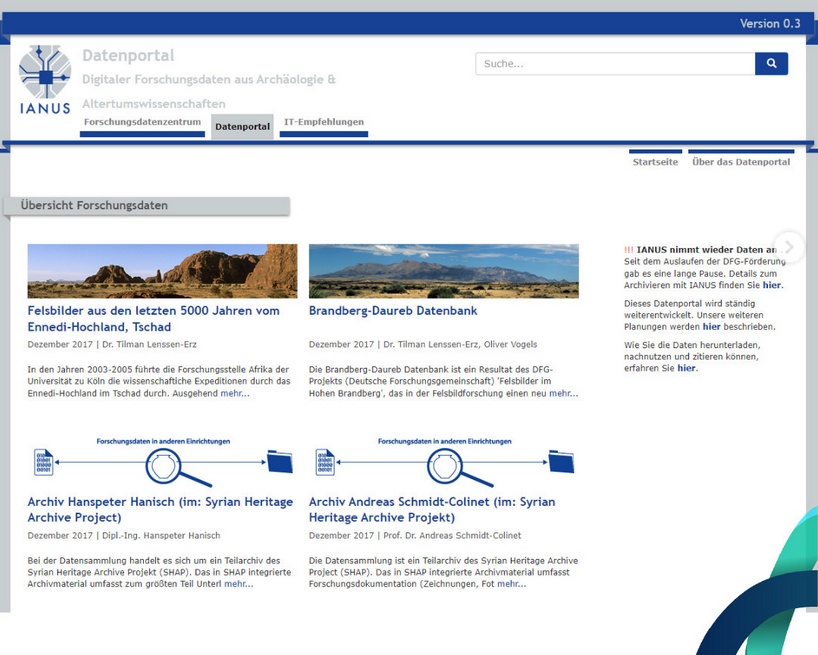
Image: IANUS data portal / IANUS
The IANUS research data centre was developed from 2011-2017 as part of a DFG project by various partners under the coordination of the German Archaeological Institute (DAI). It archives, curates and publishes archaeological data in a data portal. In our Task Area 5: Storage, Access and Dissemination, this service is being expanded, scaled and adapted to the needs of changing scientific requirements. This concerns not only the further development of the existing technical infrastructure and the modelling of processes for the processing, archiving and provision of data packages, but also the specification of open, preferably standardised and automated interfaces between data repositories, specialist systems, etc. This will enable IANUS, as a national research data centre for object-related research data, to provide our community with an infrastructure for long-term archiving and to create the technical prerequisites for object-specific research data management (RDM).
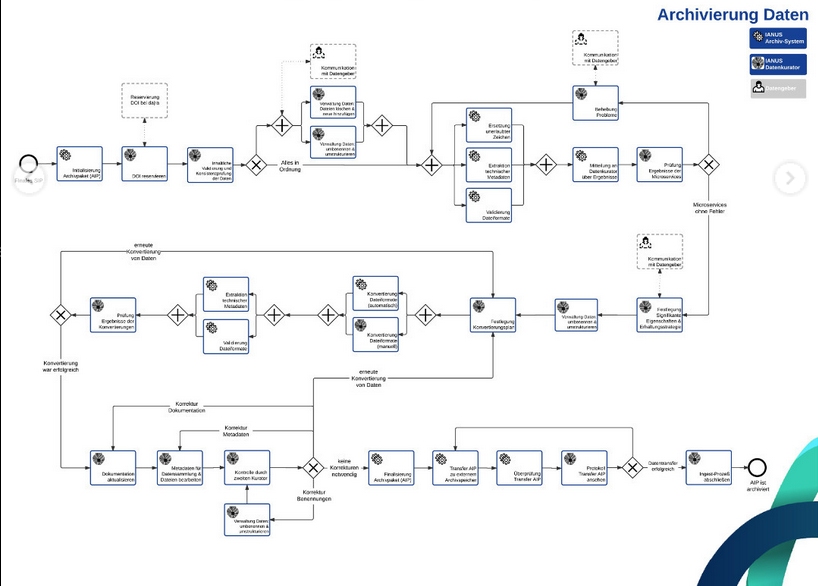
Image: Processes for processing, archiving and providing data packets / IANUS
This also involves the continuous expansion of a community-supported service infrastructure. In addition to the aforementioned technical and process-orientated aspects, the so-called IANUS IT recommendations are a key component in this context. These provide researchers with extensive background information and practical tips and primarily address topics relating to the exchange, long-term archiving and reusability of research data. The main focus is on data management and the documentation of collections with metadata. Information on data formats and detailed tips on how to handle data generated when using specific methods and technologies - from geodesy and terrain modelling to special photo documentation methods - are also included. The IANUS IT recommendations are developed and compiled together with the community - for example via GitHub - in the form of a comprehensive glossary and, above all, are constantly updated with regard to new methods and standards.
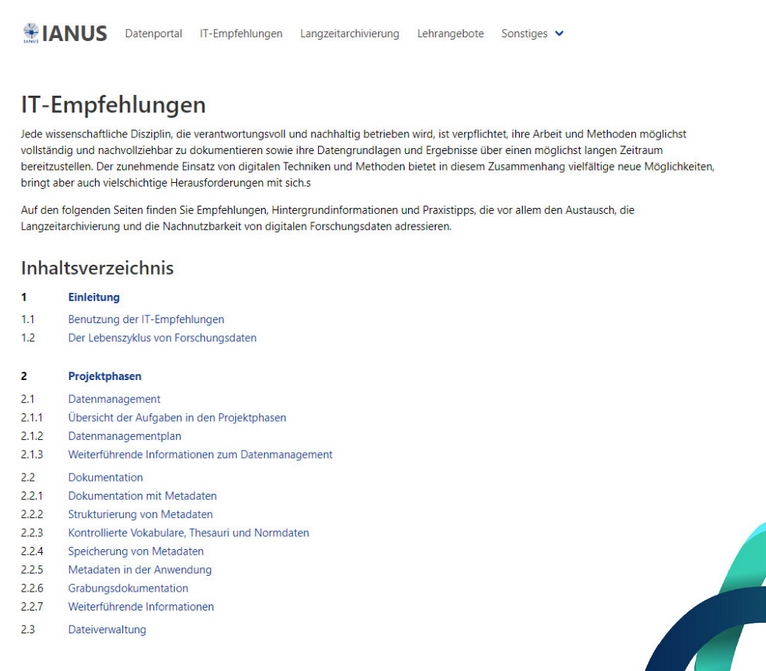
Image: IANUS IT recommendations / IANUS
In this combination of services for long-term archiving, the development and maintenance of relevant interfaces and the provision of information and RDM solutions for the community, NFDI4Objects and IANUS can become an important building block of the national research data infrastructure across the boundaries of federal states, institutions and project durations.
16.02.2024: Object biographies (TA6)
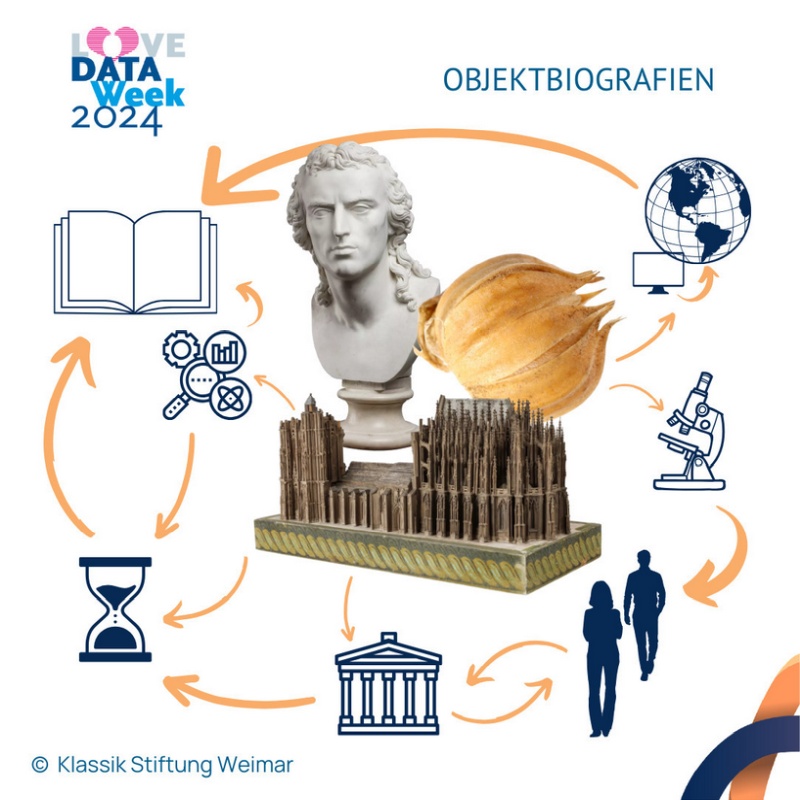
Image: Illustration of object biographies / Klassik Stiftung Weimar
In Task Area 6 of NFDI4Objects “Qualification, Integration, Harmonisation”, the Klassik Stiftung Weimar and the Competence Center for Research Data and Information at FAU Erlangen-Nürnberg are jointly developing a knowledge base on objects. Among other things, a CIDOC CRM-based data model (knowledge graph) for the description and representation of object biographies is being created on the basis of existing models and standards.
The data generated by the NFDI4Objects consortium originates from interdisciplinary research contexts, e.g. archaeology, building research, heritage conservation, collections (archives, libraries and museums), but also from materials science and archaeobotany. Digitisation contributes to sustainable preservation and indexing. The resulting very heterogeneous files and information can be linked to other information, especially in the context of the Semantic Web.
Objects are understood to be material cultural assets, e.g. buildings and their furnishings or artefacts and collection items such as coins, stones, furniture, clay tablets, vessels of all kinds, bones and seeds. In an object biography, the concept of biography is applied to material cultural assets in order to tell their ‘life cycle’, ideally from the event of their creation to the event of their end or their current state of preservation. Four questions are important here: Who, When, Where, What? Objects can thus be linked to actors, times, places and events in order to depict spatial references as well as (historical) places and processes. Individual objects and collections are also placed in relation to each other and form new contexts.
This digital data can be re-utilised and enriched with further information and findings, combined with each other and placed in a new context depending on the research question. Ontologies and metadata form an important basis for the reuse of digital editions. The latter provide human- and machine-readable information and descriptions of the respective digital resources and are divided into descriptive (content-related), structural (technical) and administrative metadata. The use of standards for consistent structure and content descriptions is essential in order to be able to reuse the data.
Sources (images, documents and databases) play a key role in the reconstruction process. Only by linking object information and sources is it possible to substantiate and contextualise statements and information attributions. By focussing on information provenance, the quality of the data is increased at the same time. Parallel statements about objects can exist at the same time, which can also be ambiguous or contradictory. At the same time, they are characterised by more or less large gaps. Their reconstruction requires excellent sources and extensive research.
As a compilation of object information, the concept of the object biography is a promising model, especially in times of big data, semantic web and knowledge graphs, for linking heterogeneous and distributed information and making it researchable from multiple perspectives and across disciplines. The CIDOC Conceptual Reference Model (CRM) as an ISO-certified description standard for the field of cultural heritage forms an ideal basis here, as this ontology is event-centred, i.e. it describes changes in status via events such as production, excavation or preparation, to which information on time, place and actor can in turn be linked and thus contextualised. In addition, events can be linked to any type of information and can therefore be directly linked to sources in which they are documented, for example.